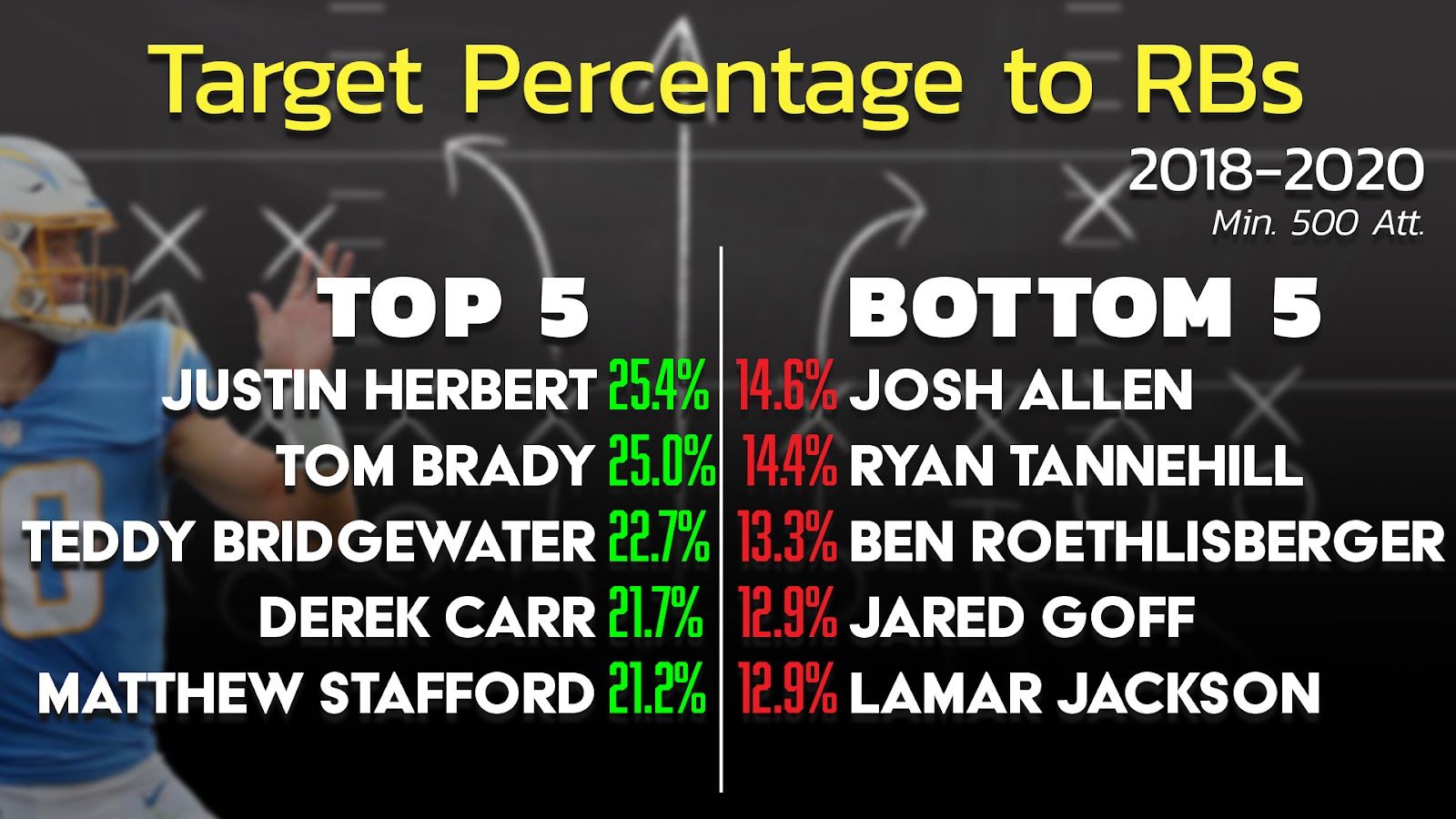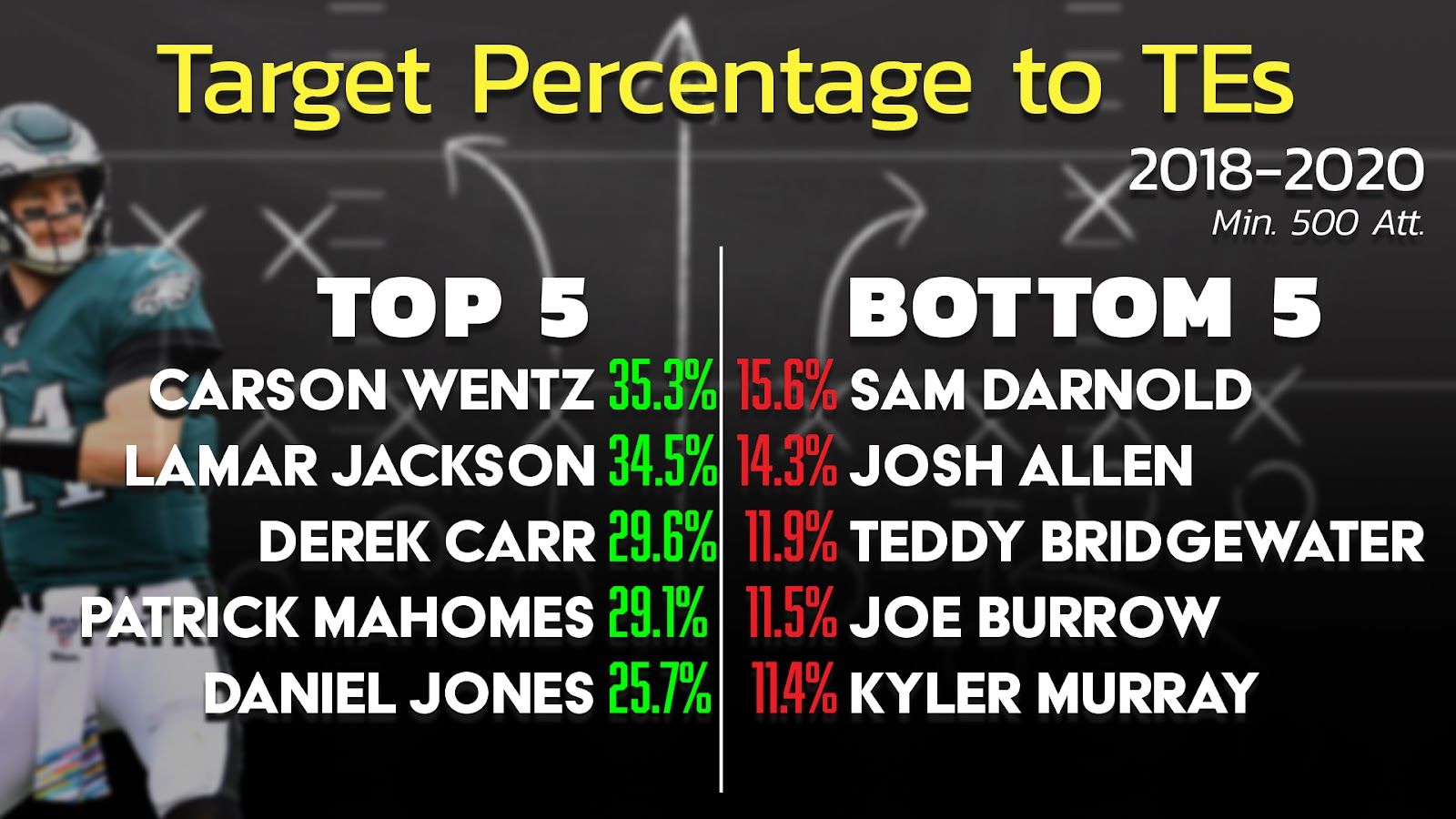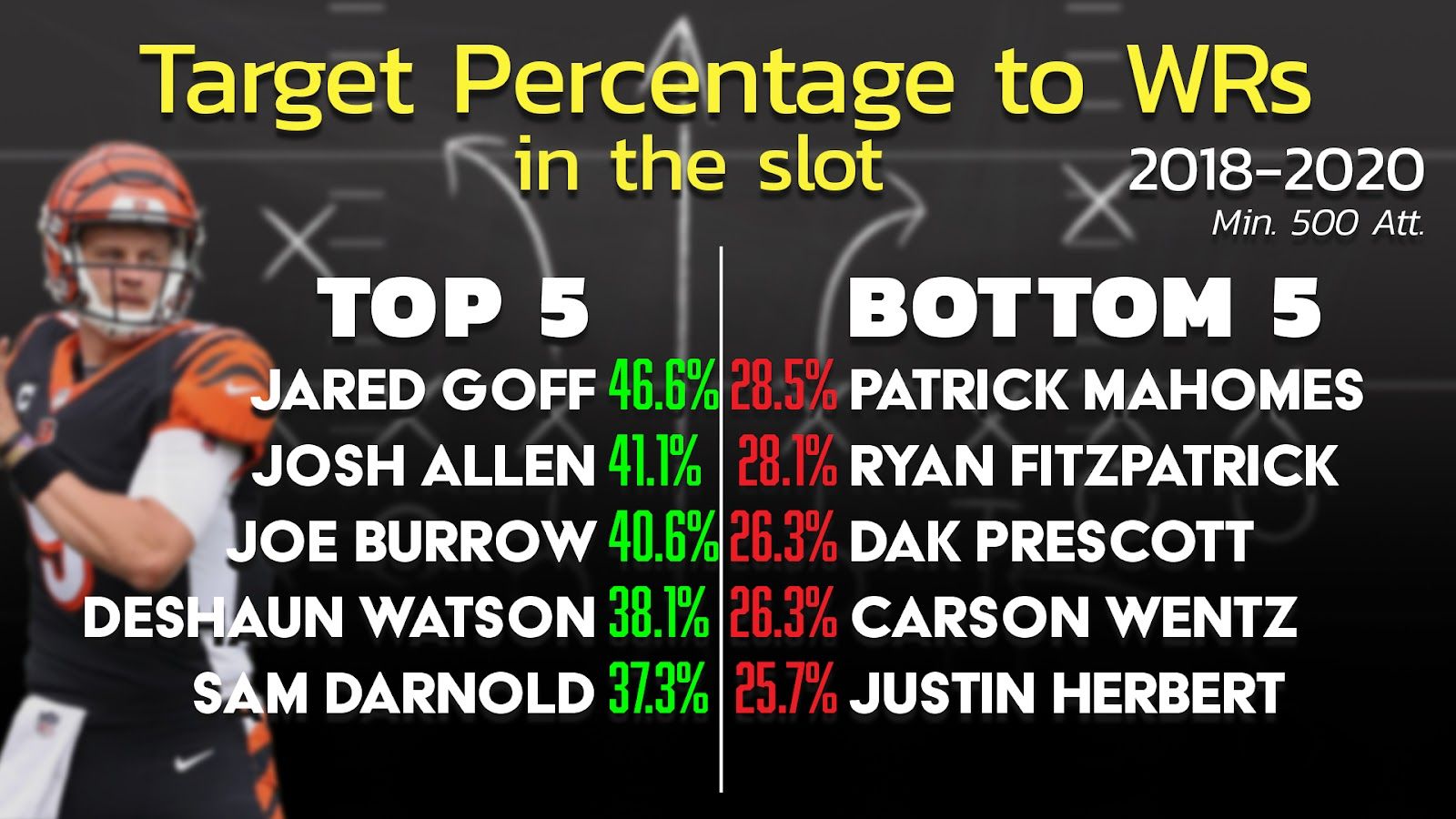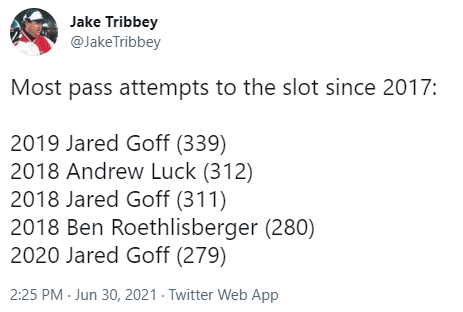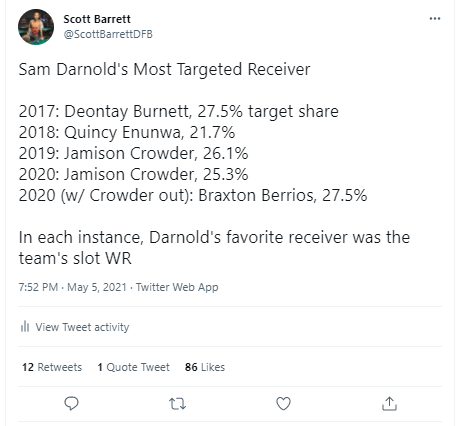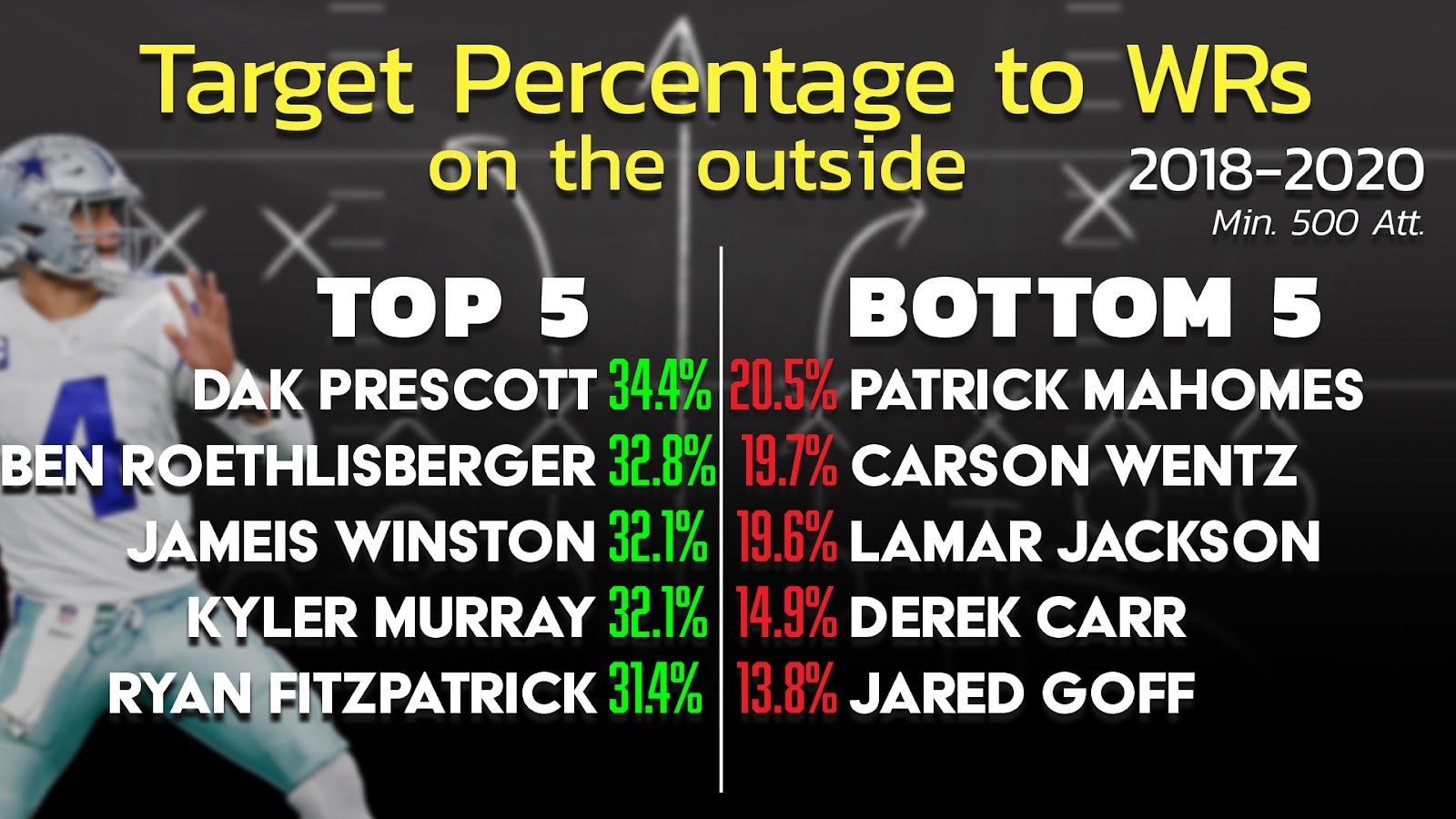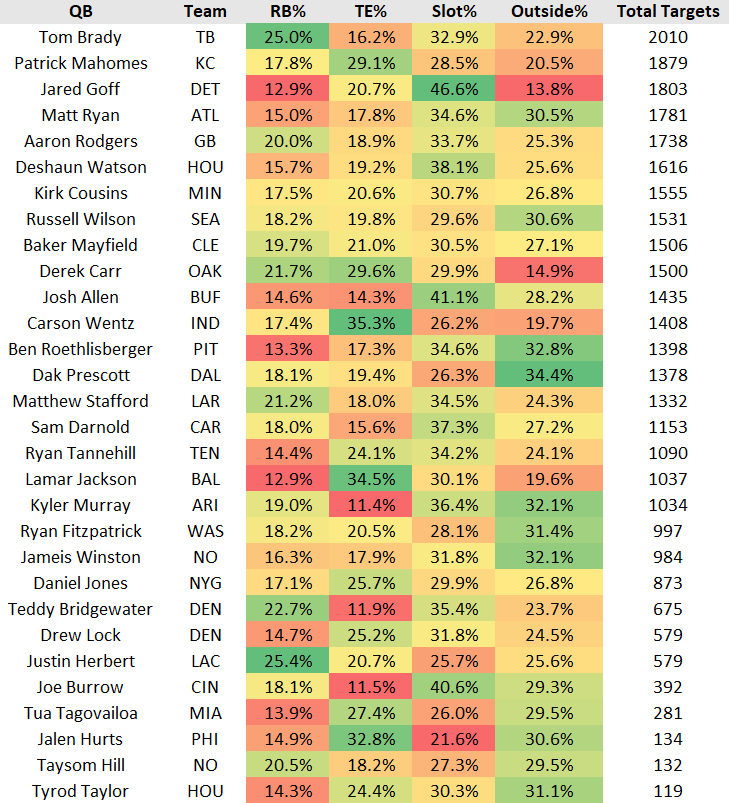There are a nearly unlimited number of factors involved in predicting outcomes in fantasy football. A good starting place is often team or coaching tendencies, and while myself and others are likely correct in the assumption that those tendencies play a larger role than QB tendencies, the QB is still the guy with the ball in his hands, and at the end of the day it is his final decision who gets targeted on any given play. Let Sean Payton coach Lamar Jackson, and I'll guarantee you he will target Alvin Kamara less frequently than Drew Brees.
With this in mind, I’m going to dive into QB positional target tendencies for all potential 2021 starting QBs over a three year sample size (2018-2020). Using this data, we can dial in on the QBs who target RBs, TEs, slot WRs or outside WRs at the highest/lowest rates, and attempt to separate signal from noise to see what the most valuable trends are heading into 2021.
Two important points before we get started, this data will be heavily skewed by sample size and a QB’s surrounding cast. 2nd-year QBs like Jalen Hurts or Tua Tagovailoa have thrown very few passes, and thus, their target tendencies are much more likely to be noise than, say, Tom Brady’s. In regards to supporting cast, it should go without saying that if Travis Kelce is on your team, you are going to target TEs more because he’s a future hall of famer. I’ll do my best to acknowledge both of these factors in the analysis below.
Scroll to the bottom for full chart of targets and percentages.
Running Backs
Upon first glance, Justin Herbert’s 25.4% RB target rate gives us an eggplant emoji for Austin Ekeler. However, it’s crucial to remember that 1) we’re dealing with an infinitesimally small sample size and 2) we are dealing with a new coaching staff in Los Angeles. OC Joe Lombardi hasn’t called plays since his stint as Lions’ OC from 2014-2015, and that obviously leads to a lack of clarity in regards to what this new Chargers offense will look like. When you glance back to his 2014 season (his only full season as an OC) the Lions targeted RBs on 28% of pass attempts. That number led the league in 2014, and is even +7% higher than Stafford’s average from 2018-2020. The three-way committee and 3.8 YPC Detroit RBs suffered through in 2014 doesn’t help the bull-case argument for Ekeler, but Lombardi has noted his offense will closely resemble that of New Orleans, and no LAC RB resembles Alvin Kamara quite like Austin Ekeler. For 2021, Ekeler has as good a chance as any RB to lead the position in targets, and that’s what really matters in PPR. That guaranteed pass-catching workload locks in Ekeler as a mid- to low-end RB1 at worst, and the only question is - with regard to where to rank him - how much rushing work will he receive? He saw just 29.6% of the Chargers total RB carries and 12% of goal line carries last year, and still finished as RB11 in FPG. That’s a low-end RB1 floor, and in the unlikely event he can capture more than 50% of the backfield carries, a top-5 RB ceiling in PPR.
Since 2018, Tom Brady has ranked 1st, 2nd, and 3rd in targets to RBs. Are we underrating Giovani Bernard (RB59) in PPR? Given how effective both Ronald Jones and Leonard Fournette have been as receivers, I think so. Sure, Fournette was a bell cow in the playoffs, but he still never recorded an above average (>60.0) PFF receiving grade in any individual playoff game. And he offered the 7th-worst drop rate (12.2%) and 13th-worst passer rating when targeted (87.8) of any RB with 25+ targets in the regular season (47 qualifiers). RoJo was, somehow, even worse, the 3rd-worst passer rating when targeted (73.7) and the worst PFF receiving grade (29.6) among RBs in 2020. The Buccaneers coaching staff is obviously aware of this massive backfield receiving deficiency, and they acted accordingly by signing Bernard. Given the Bucs had the 5th-most targets to RBs last year (119), Bernard should have quite a few targets come his way in 2021. He’s a great late-round dart-throw if he can capture around half of the team’s backfield targets, as Bernard hasn’t finished worse than overall RB40 in any of the six seasons he’s earned 50+ targets.
Derek Carr’s RB target rate comes as a bit of a surprise, given Las Vegas really hasn’t had a fantasy-relevant pass catching back since Jalen Richard finished as RB29 in 2018. In fact, Richard is the only LV RB in our three year sample to surpass 45 targets in any individual season. HC Jon Gruden seems to like spreading out the volume among his pass catching backs, and if Kenyan Drake can dominate that pass catching role like Richard did in 2018, when he saw 81 targets, he could become one of the most targeted RBs in football. Starting RB Josh Jacobs isn’t a threat to siphon crucial RB pass game work, as Jacobs has just one career third-down target, and just 12 career targets when the Raiders are down multiple scores. With the Raiders implied by oddsmakers to win just 7 games, there is going to be a lot of opportunity for their lead pass catching RB to thrive, and if that player is Drake (which is likely), he makes for an intriguing PPR option at RB36.
These numbers make me optimistic that the potential of Taysom Hill starting in New Orleans won’t harm Alvin Kamara’s PPR output as much as I initially believed. Unlike most other Konami Code options, it’s encouraging to note that despite Taysom’s mobility and the historical sample we have with hyper-mobile QBs not targeting RBs it appears Sean Payton’s system won out, albeit on a super small size. It’s important to remember, though, that Kamara did still take an FPG and targets per game hit despite that RB target rate, due to an overall reduction in passing volume and goal line/red zone work. In the four games Hill started, Kamara posted just 14.2 FPG and 4.0 targets per game, which is a far cry from the 29.2 FPG and 8.3 targets he averaged in his 11 other games. Regardless of who wins the QB job in NO, neither Hill nor Jameis Winston are likely to recreate the league-leading 27.1% of pass attempts to RBs that human statue and all-time legend Drew Brees posted in our sample. The NFL’s swag captain (Kamara) almost certainly suffers here.
Are we underrating Chris Carson (RB22) in PPR? It looks like it. Russell Wilson’s 18.2% RB target rate certainly surprised me, and Carson has been, and will continue to be the main beneficiary. Checking his 2020 numbers, Carson averaged 3.8 targets per game (t-18th most among RBs), more than ‘pass catching specialists’ Kareem Hunt, Duke Johnson, or Chris Thompson. He also finished 2020 as RB13 in FPG despite dealing with both an MCL sprain and ankle sprain during the season. And he finished as the overall RB10 in the 2019 fantasy season. With his only backfield competition being Travis Homer, Deejay Dallas, and the always-injured Rashaad Penny, Carson’s role faces far less uncertainty in PPR than most other RBs in the RB18-24 range of ADP. He’s a clear PPR value at cost. To the surprise of nobody, Lamar Jackson winds up at the very bottom of RB target rates. A Konami code superstar like Jackson just isn’t going to target RBs at the same rate as a pocket passer. Reports about a potential uptick in targets for Ravens RBs may be true, but I’m not expecting anything close to a significant increase. Some extra swing passes and screens? Sure, but Jackson isn’t going to drastically alter his tendencies to get these RBs the ball through the air more often.
Jared Goff tying with Lamar Jackson in RB target rate is certainly surprising, but remember our sample leaves out McVay’s first year as HC in 2017, when Todd Gurley’s powers were peaking, and the Rams targeted RBs at a much more normalized 19% clip. That suggests, to me at least, that Goff’s pitiful RB target rate is mainly a function of the Rams personnel, as they’ve had excellent receivers and exceedingly poor pass catching talent out of the backfield for at least two-thirds of our sample. With Goff now in Detroit, alongside a pair of strong pass catching RBs in D’Andre Swift and Jamaal Williams, we can safely assume his RB target rate will drift much closer to the league-wide average (17.6%) in 2021.
For new LAR QB Matthew Stafford, I’d expect his (4th-highest) RB target rate to fall to below average given the mediocre RB depth after losing Cam Akers. The combination of Darrell Henderson, Xavier Jones, and Jake Funk are unlikely to match the backfield receiving talent Stafford has had access to over the last three seasons in Detroit, while playing alongside noteworthy pass catching backs like J.D. McKissic, Theo Riddick, and D’Andre Swift.
Ben Roethlisberger’s RB target rate is certainly eye-popping, at a lowly 13.3%, but let’s look beyond our three year sample. In the seasons Le’Veon Bell played at least 12 games for PIT from 2013-2017, Bell ranked eighth, second, first, and t-first in RB targets per game. If you think Big Ben’s RB target rate from these last three years was an aberration (which I do), then you should love Najee Harris (who Graham Barfield comp’d to Bell pre-draft) at cost in pretty much all formats, but especially PPR.
Tight Ends
No QB in our sample has targeted TEs like Carson Wentz, and now he lands in Indianapolis, a team that’s targeted TEs on 26% of their pass attempts (4th-most), resulting in the 4th-most FPG (16.7) for the Colts’ TE room since HC Frank Reich took over in 2018. Not to mention that Reich was Wentz’s OC in 2017, when Eagles TEs averaged 19.6 FPG, leading the league that season. That resulted in the best season (fantasy or otherwise) of Wentz’s career. And let’s not forget Reich’s stint as Chargers’ OC, when his TE room ranked 5th, and then 4th, in cumulative FPG. This is a match made in heaven. Mo Alie-Cox (TE33), Jack Doyle (TE36) and Kylen Granson (TE55) are all ridiculously cheap, but unfortunately the very likely risk of Indy spreading the ball out between the three of them negates high-end upside for the individual TEs.
Unlike Indy, Lamar Jackson’s TE targets were highly concentrated. Mark Andrews saw the third-highest TE target share in 2020 at 24.4%, but let’s remember that Baltimore’s receiving corps has been largely devoid of talent since Lamar took over at QB. The additions of Rashod Bateman and Sammy Watkins are quite likely to lower both Andrews target share, and the % of targets going to TEs in this offense.
Similar to Lamar Jackson, Jalen Hurts' high percentage of throws to TEs is likely more of a consequence of personnel than scheme than QB tendencies, plus we have the added wrench of a minuscule sample and an offseason coordinator change. Given that Hurts’ never ranked in the top-50 among college QBs in TE target rate, I’m not sure there’s much we can meaningfully extract from his placement on this list.
Tua Tagovailoa’s TE target rate is quite intriguing, but similar to Jalen Hurts, our sample size may be too small to draw any meaningful conclusions. His college data didn’t show any meaningful preference towards targeting TEs, so I’m of the belief that this was primarily a result of personnel. With Preston Willams hurt for half the season, Miami’s second-most talented pass catcher was Mike Gesicki. I’m a believer in Gesicki’s ability as a receiver, but he’s certainly no better than the fourth-best pass-catching option given the upgrades this WR corps has gone through recently. I’m expecting that TE target rate to fall off as a result in 2021.
Keeping with that theme, Daniel Jones hasn’t had a very talented group of WRs to throw to in his time in NY, and that’s benefitted Evan Engram, who earned a 22% target share in 2020. The additions of Kadarius Toney and Kenny Golladay seriously bolster this WR room, and that’ll almost certainly knock Engram down a peg to a target share of around 15-18%. I’m viewing Engram as a high-end TE2 (with appealing upside), and with an ADP of TE15, the market seems to agree.
Tom Brady has a plethora of TE talent in Tampa Bay, but he certainly didn’t in his final two seasons in New England, which massively skews our sample. In the 2020 regular season, Brady’s TE target rate was 21.4%, which is an above-average mark when compared to the other QBs in our three-season sample. I’m anticipating similar volume towards TB TEs this season, but I’m not sure any Buccaneer TE has appealing upside with three talented players competing for those targets. I’d much rather take a shot on a Colts’ TE (which is an equally competitive situation) as they are far cheaper in all formats.
Slot Wide Receivers
Jared Goff obviously jumps out in a big way, clocking in with a 5.5% higher slot target rate than the No. 2 QB, Josh Allen. So is this absurd slot target rate a product of Goff’s tendencies or HC Sean McVay’s scheme?
I’m not smart enough to figure that out, so I reached out to someone who is: Wes Huber. Here’s what he had to say when it came to discerning if this is a result of coaching scheme or QB tendencies. “It’s all about yards gained on play action passing using bunched formations. With the WRs packed tightly just off the line, Sean McVay loves to run his post-and-deep crosser combination with Robert Woods and Cooper Kupp. Whichever of the two is stationed on the outside, he’s asked to run a post/glance pattern, with the other WR in the slot on the deep crosser. Using play action to create plenty of pocket space for his QB, sometimes in combination with a receiver running a reverse/end around/jet sweep fake, the defense is forced to consider a long list of read keys.”
“It all boils down to numbers, where McVay has been masterful in using essentially the exact same plays repeatedly, but dressing them up with slight variations for his No. 2/slot WRs to get open. Unfortunately for Jared Goff, he will not be bringing McVay along with him to Detroit. Should Goff continue to find success working to his No. 2’s, it’ll be due to an individual receiver’s ability (Amon-Ra St. Brown?) rather than that type of scheme ingenuity that provided him with the numbers we see.”
I’m looking for a jump in Matthew Stafford’s slot target rate while also anticipating a regression to the league-wide mean (32%) for Goff’s.
Josh Allen’s sky-high slot target rate is primarily a function of the awesome receiving talent Buffalo has playing in the slot. Last season, Cole Beasley ranked 2nd in PFF slot receiving grade (90.8), 6th in YPRR from the slot (2.31), and 10th in WAR generated from the slot vs man coverage (0.3). Stefon Diggs was arguably more impressive, recording the 6th-best PFF slot receiving grade (85.2), the 2nd-most YPRR from the slot (2.99), and the 2nd-best slot WAR vs man coverage (0.5). Both players are skilled enough to essentially get open at will, and it’s translated to high volume and excellent efficiency from the slot. I don’t see that changing anytime soon.
My initial thought in regards to Joe Burrow’s presence on this list was that it was due to him wanting to get the ball out of his hands quickly to avoid pressure. That appears to be partially true, as Burrow recorded the 8th quickest average time to throw (2.61 seconds) out of 29 qualifying QBs while playing behind PFF’s 6th-worst pass blocking OL. With that being said, a peak into Burrow’s 2019 college numbers also suggests he may have a natural predisposition towards throwing at his slot WRs. Of the 101 2019 college QBs with at least 200 pass attempts, Burrow’s slot target rate of 41.7% ranked 7th, and led to, not surprisingly, the second-most slot passing yards of any college QB since at least 2016. A fourth-straight 100+ target season for Bengals’ slot-specialist Tyler Boyd seems highly likely, or, at the very least, a terrific bet in contrast to current ADP (WR36).
Similar to Burrow, Sam Darnold's propensity for targeting the slot seems to go back to his days in college. In each of his two starting seasons in 2016 and 2017, Darnold posted slot target rates of 42.6% (13th of 99 qualifiers) and 34.8% (24th of 98 qualifiers). We know that tendency has translated to the NFL, so what does it mean for the Carolina Panthers receivers? OC Joe Brady has a penchant for moving his WRs around the formation as much as any coordinator (every Panthers WR had a slot snap rate of at least 22% last year), but the guy who led the team in slot snaps last year, Curtis Samuel, is no longer in Carolina. That leaves Robby Anderson (2nd on the team in 2020 slot snaps) as the presumptive favorite to take most of those reps. If that happens, Anderson - who already has an established rapport with Darnold - could offer legit WR1 upside at a low-end WR3 price tag. I’ll be paying close attention to who earns the Panthers’ slot reps during the preseason, because that’s highly likely to be the most valuable receiving role on the team.
Kyler Murray ranked highly here, so does that mean big things for 2nd-round pick Rondale Moore, who recorded 83% of his college receiving yards in the slot? Well, maybe. Over the past two seasons Arizona had 435 dropbacks with 4 WRs on the field, while the next closest team, Buffalo, had just 118 dropbacks with 4 WRs in the formation. Those 4 WR formations effectively double the number of slot WRs on the field. That’s a lot of extra slot routes, and consequently, slot targets in Arizona because of coaching tendencies. At the individual player level, slot man Larry Fitzgerald saw 90 slot targets in 2019 (11th-most) and 67 in 2020 (23rd-most). While the borderline-boomer in Fitzgerald never turned those targets into much from a fantasy perspective, Rondale Moore is a YAC monster. Moore could certainly transform that slot role into a productive one for fantasy purposes, and with an ADP of WR64, he’s a lock to outperform his draft position if he winds up as a full-time starter in the slot for the Cardinals. And, based on HC Kliff Kingsbury’s comments, that also feels like a lock.
Jalen Hurts and Tua Tagovailoa had very little talent in the slot last season and offered a small sample size, so I’m not sure we can discern much from their minimal slot target rates. Looking back at their college stats, Tua really jumps out, as he targeted the slot at a 41.7% clip in 2018 (6th of 104 qualifiers) and a 39.7% rate in 2019 (11th of 101). Now that he’s more comfortable in the offense, could Tagovailoa dial in on rookie and former college teammate Jaylen Waddle in the slot? Absolutely, given Waddle’s absurdly good numbers on a 91% career college slot yardage share. Hurts will also be getting some added slot help, with 2nd-year WR Jalen Reagor reportedly moving there this season. Reagor is no Waddle, but he does carry similarly high draft capital, and he should at least be a massive upgrade from Greg Ward, who ranked third-worst in PFF slot receiving grade (56.2) and 8th-worst in slot passer rating when targeted (84.2).
Justin Herbert posting the 2nd-lowest slot target rate came as a surprise given the presence of perennial pro-bowler Keenan Allen, but it’s important to remember he’s played almost exactly half his snaps from the slot in each of the past three seasons, so he’s far from a ‘slot-only’ target hog. When you combine that with the ridiculously high RB target rate, and recall that the Chargers #2 and #3 receivers (Mike Williams and Hunter Henry) both siphoned targets away from slot WRs, that number really starts to make sense. For 2021, I’m expecting Herbert’s slot target rate to increase, given the comments from OC Joe Lombardi about his offense resembling that of New Orleans. So who benefits? Well, it looks like Williams more so than Allen, as Lombardi suggested Mike Williams will play ‘X receiver’ - Michael Thomas’ position with the Saints - and stated that if he were a betting man, he would “bet on nice numbers coming from him on the stat sheet, that's for sure."
Outside Wide Receivers
With Cole Beasley in 2018, Randall Cobb in 2019, and now CeeDee Lamb all having successful tenures as the starting slot in Dallas, Dak Prescott hasn’t had a shortage of talent to throw at between the numbers. That still hasn’t phased him, as no QB has thrown to outside receivers at a higher clip than Prescott, while his slot target rate from our sample ranks bottom five. Diving into the individual seasons, 2020 really stands out, as Dak threw to his slot WRs at a 32.9% rate - the highest of his career. 2020 is our smallest sample for Prescott (at just 5 games played), but even when Prescott was off the field, the Cowboys still made a concerted effort to get the ball to the slot, with CeeDee Lamb recording the 5th-most slot targets (67) from Weeks 6-17. Needless to say, I’m certainly not moving CeeDee down draft boards based on this data, but a strong argument could absolutely be made that Amari Cooper (ADP 40/WR16) should be the first Dallas WR drafted in all formats, not Lamb (ADP 32/WR12), given that — despite abysmal QB-play last year and battling through a record number of injuries in 2019 — Cooper has averaged an impressive 15.7 FPG since being traded to Dallas.
In each of the last three seasons, Ben Roethlisberger’s highest targeted player has been a WR who plays at least 75% of their snaps lined up out wide. First Antonio Brown, now Diontae Johnson. With Chase Claypool having now emerged as another dominant outside force, the Steelers two best receiving talents will be playing almost exclusively outside in 2021. The odd man out is obviously Juju Smith-Schuster, and while he should still earn close to 100 targets, he’s also been suffering from poor receiving efficiency the last two years. In 2019 and 2020, respectively, Smith-Schuster earned a PFF slot receiving grades of 64.8 (35th of 41 qualifiers) and 68.7 (28th of 40) while posting a slot YPRR 1.28 (30th) and 1.35 (30th). The result? Zero games of over 25.0 fantasy points these last two seasons. Smith-Schuster unfortunately presents the lowest game-to-game and season-long upside of this trio.
The recent (and quite confusing) continuation of the Michael Thomas injury saga does make it less likely, but it goes without saying that Jameis Winston starting at QB in New Orleans would be massive for Tre’Quan Smith. Yes, I know, Smith isn’t an exclusively outside WR (career 48.5% slot snap rate), and he’s obviously not Mike Evans, but he is the clear favorite to lead this incredibly soft WR room in targets, at least early-on. The potential of Taysom Hill starting won’t limit Smith’s ability to be the Saints’ WR1, but it will lower their pass rate and increase the average time between offensive plays, as we saw the Saints go from a 54% pass rate and 28.1 seconds per play with Drew Brees as the starter in 2020 to 48% and 30.3 seconds per play with Hill. Regardless, Smith is absolutely a value at his current ADP (WR64) as there is hardly anyone else to throw to in New Orleans.
I didn’t think I could be more bullish on Terry McLaurin, but here we are. Dwayne Haskins and Alex Smith didn’t give the stellar-talent in McLaurin much to work with, as they only threw 23% of their targets to outside WRs in our sample. To make matters worse, if treated as one player the QB duo of Smith and Haskins combined for a 77.8% catchable target rate (31st of 44 qualifiers) and a 6.2 aDOT (the lowest of any QB with more than 40 attempts). New QB Ryan Fitzpatrick should improve on nearly everything that was wrong with the Smith/Haskins offense. A naturally aggressive thrower, Fitzpatrick has finished in the top-10 in QB aDOT in 4 of the last 5 seasons, and did so under four different offensive coordinators. McLaurin should be seeing more total targets given Fitzpatrick’s outside WR target rate, and those targets should be more accurate, as Fitz finished 10th among QBs in catchable target rate (81.6%) last year. And, did I mention McLaurin played through TWO high ankle sprains last year and averaged 17.7 FPG prior to injury? In my opinion, McLaurin is being drafted at his stone-floor of WR10, and has as good of a chance as any WR to finish as the overall No. 1 player at the position.


